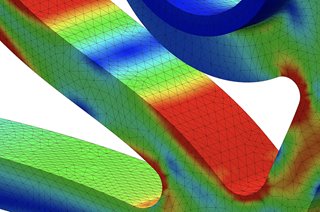9 Popular Engineering Software to Streamline Design
9 Popular Engineering Software to Streamline Design


Understanding how to use engineering software is critical for reducing errors and expanding design capabilities. Here are nine popular software packages for mechanical engineering.
Understanding how to use engineering software is critical for reducing errors, saving time, and expanding design capabilities. Being skilled with software packages is also a talent that engineering recruiters and headhunters look for, especially as a widening skill gap exists for engineers of all types in the U.S. The more adept you are with analytical software, the more competitive you are as an employee or job candidate.
Below are nine engineering software packages that help streamline design and production processes, resulting in shorter lead times, more projects in the pipeline, faster time to market, and improved end-user satisfaction and brand awareness.
A good example of production control and shop-floor management software is Prodsmart, which helps manufacturers track floor activity and streamline production workflow. In real-time, it can analyze all aspects of manufacturing operations, including orders, workers, materials, machines, maintenance, waste, time, and costs. Any custom parameter can be analyzed by period, machine, worker, product, section, or operation. Tracking overall equipment effectiveness and traceability helps optimize manufacturing processes and increase uptime.
Staad Pro is a structural finite element analysis and design software with strong visualization tools and a wide range of international design codes. Engineers can automatically convert physical models into analytical models for conducting the structural analysis. The program can perform analysis on any structure exposed to static, dynamic, wind, earthquake, thermal, and moving loads for any material. Calculations include moment and shear, movement, geometric non-linear, steady-state, buckling, cable, pushover, and floor spectrum.
Editor’s Pick: Digital Engineering During COVID-19
Plaxis simulates complex geological conditions that may affect a project. It uses finite element analysis in 3D to model and analyze geo-engineering projects. Engineers can use Plaxis to create finite-element models, determine realistic assessments of stresses and displacements, and improve multidisciplinary workflows. It can also model and analyze complex soil profiles, structural elements such as piles, anchors, geotextiles, loads and displacements, and deformation and stability in geotechnical engineering and rock mechanics.
FEA is one of the most essential mechanical software tools for structural analysis. It tests the design for any fatigue by simulating the situation and determining failure points. Stresses and deflections in complex structures can be simulated and test by applying forces and constraints. A popular FEA package is ANSYS, which can simulate complex structural shapes and test new materials’ limits. Simulations include static structural and thermal, dynamic, weight optimization, vibration mode, and safety factor simulations.
Engineering calculations are essential for every step of the design process. Engineering teams need a comprehensive yet easy-to-use software that performs calculations, enables traceability, and protects intellectual property. Mathcad is a popular program that allows engineers to do math within a document, including writing and evaluating equations, unit conversion, plotting, linear algebra, and programming. This work can be saved and presented alongside plots, text, and images in a single, professionally formatted document.
Modeling and simulation are essential for designing and analyzing new products, especially as products and their components become smaller and more complex. A variety of modeling programs are available. CATIA allows mechanical engineers to repurpose and redesign existing 3D design data to update product design and support documentation and technical illustrations. Another program is Rhino 5, which provides thousands of modeling and editing tools. Applications include analysis and translation of curves, surfaces, solids, point clouds, and polygon meshes.
Matlab, which helps with complex analysis or calculations, is one of the most extensively used programming languages in mechanical engineering. Popular features are the ability to plot and analyze huge volumes of data, develop algorithms, and creating models. Python is a general-purpose programming language and an excellent alternative to Matlab. It uses an object-oriented approach that helps developers write clear, logical codes for projects of all sizes. Python can also generate customized calculation tools that speed up engineering calculations.
Knowledge of software design is unavoidable for engineers, and that includes coding. Engineers can teach themselves coding, but it is often time-consuming and challenging. A visual short-cut is programming devices by dragging and dropping interfaces using specific sequences of logic. One of these programs is Wyliodrin, which allows users to build programs using a variety of coding languages.
Hydraulic systems can be quite complex, with thousands of parts and challenging geometries. HydroSym is a program that easily designs the schematics for any hydraulic system using a vast array of smart tools. Engineers can also take advantage of the built-in comprehensive component library that contains over 40,000 components and symbols, including up-to-date datasheets and extensive product information. HydroSym is also well-suited for designing pneumatic systems.
Recommended for You: The Future of Artificial Intelligence Domination
These are just a few of the leading software programs that make mechanical engineering faster and more accurate, as well as enable more complex projects and designs. Gaining hands-on experience with engineering software not only expands professional knowledge, but it also improves your chances of landing a job in the mechanical engineering field.
Mark Crawford is a technology writer based in Corrales, N.M.
Register Today for Digital Engineering: The Manufacturing Tools of Tomorrow
Below are nine engineering software packages that help streamline design and production processes, resulting in shorter lead times, more projects in the pipeline, faster time to market, and improved end-user satisfaction and brand awareness.
1. Production Control
A good example of production control and shop-floor management software is Prodsmart, which helps manufacturers track floor activity and streamline production workflow. In real-time, it can analyze all aspects of manufacturing operations, including orders, workers, materials, machines, maintenance, waste, time, and costs. Any custom parameter can be analyzed by period, machine, worker, product, section, or operation. Tracking overall equipment effectiveness and traceability helps optimize manufacturing processes and increase uptime.
2. Structural Analysis
Staad Pro is a structural finite element analysis and design software with strong visualization tools and a wide range of international design codes. Engineers can automatically convert physical models into analytical models for conducting the structural analysis. The program can perform analysis on any structure exposed to static, dynamic, wind, earthquake, thermal, and moving loads for any material. Calculations include moment and shear, movement, geometric non-linear, steady-state, buckling, cable, pushover, and floor spectrum.
Editor’s Pick: Digital Engineering During COVID-19
3. Geotechnical
Plaxis simulates complex geological conditions that may affect a project. It uses finite element analysis in 3D to model and analyze geo-engineering projects. Engineers can use Plaxis to create finite-element models, determine realistic assessments of stresses and displacements, and improve multidisciplinary workflows. It can also model and analyze complex soil profiles, structural elements such as piles, anchors, geotextiles, loads and displacements, and deformation and stability in geotechnical engineering and rock mechanics.
4. Finite Element Analysis (FEA)
FEA is one of the most essential mechanical software tools for structural analysis. It tests the design for any fatigue by simulating the situation and determining failure points. Stresses and deflections in complex structures can be simulated and test by applying forces and constraints. A popular FEA package is ANSYS, which can simulate complex structural shapes and test new materials’ limits. Simulations include static structural and thermal, dynamic, weight optimization, vibration mode, and safety factor simulations.
5. Engineering Calculations
Engineering calculations are essential for every step of the design process. Engineering teams need a comprehensive yet easy-to-use software that performs calculations, enables traceability, and protects intellectual property. Mathcad is a popular program that allows engineers to do math within a document, including writing and evaluating equations, unit conversion, plotting, linear algebra, and programming. This work can be saved and presented alongside plots, text, and images in a single, professionally formatted document.
6. Modeling 3D Data
Modeling and simulation are essential for designing and analyzing new products, especially as products and their components become smaller and more complex. A variety of modeling programs are available. CATIA allows mechanical engineers to repurpose and redesign existing 3D design data to update product design and support documentation and technical illustrations. Another program is Rhino 5, which provides thousands of modeling and editing tools. Applications include analysis and translation of curves, surfaces, solids, point clouds, and polygon meshes.
7. Programming
Matlab, which helps with complex analysis or calculations, is one of the most extensively used programming languages in mechanical engineering. Popular features are the ability to plot and analyze huge volumes of data, develop algorithms, and creating models. Python is a general-purpose programming language and an excellent alternative to Matlab. It uses an object-oriented approach that helps developers write clear, logical codes for projects of all sizes. Python can also generate customized calculation tools that speed up engineering calculations.
8. Coding
Knowledge of software design is unavoidable for engineers, and that includes coding. Engineers can teach themselves coding, but it is often time-consuming and challenging. A visual short-cut is programming devices by dragging and dropping interfaces using specific sequences of logic. One of these programs is Wyliodrin, which allows users to build programs using a variety of coding languages.
9. Hydraulic Systems
Hydraulic systems can be quite complex, with thousands of parts and challenging geometries. HydroSym is a program that easily designs the schematics for any hydraulic system using a vast array of smart tools. Engineers can also take advantage of the built-in comprehensive component library that contains over 40,000 components and symbols, including up-to-date datasheets and extensive product information. HydroSym is also well-suited for designing pneumatic systems.
Recommended for You: The Future of Artificial Intelligence Domination
These are just a few of the leading software programs that make mechanical engineering faster and more accurate, as well as enable more complex projects and designs. Gaining hands-on experience with engineering software not only expands professional knowledge, but it also improves your chances of landing a job in the mechanical engineering field.
Mark Crawford is a technology writer based in Corrales, N.M.
Register Today for Digital Engineering: The Manufacturing Tools of Tomorrow












